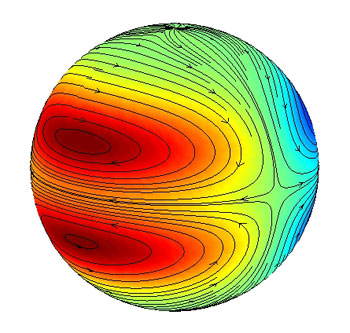|
Neutron Star Oscillations
Each time you ring a bell it makes a similar sound, which is determined by its natural modes of oscillation. Neutron stars are no different. Either from temperature sensitive nuclear reactions, thermonuclear explosions, or the torquing of magnetic fields, neutron stars can be set ringing. Because of their interesting and complicated structure (with an ocean and crust) the study of these oscillations is very rich. Ultimately, the observations of these modes of ringing could be used to learn about the interior structure of neutron stars just as seismology is used to study our Earth. Unstable Nonradial Oscillations on Helium Burning Neutron StarsMaterial accreted onto a neutron star can stably burn only when the accretion rate is high or if a large flux from the neutron star crust permeates the outer atmosphere. For such situations we have analyzed the stability of nonradial oscillations, finding one unstable mode for pure helium accretion. This is a shallow surface wave that resides in the helium atmosphere above the heavier ashes of the ocean. It is excited by an increase in the triple-alpha nuclear reaction rate during the oscillations. For a slowly rotating star, this mode has a frequency of approximately 20-30 Hz, and we calculate the full spectrum that a rapidly rotating (>>30 Hz) neutron star would support. The short period X-ray binary 4U 1820--30 is accreting helium rich material and is the system most likely to show this unstable mode, especially when it is not exhibiting X-ray bursts. Related Links: What do Nonradial Oscillations Look Like? - Ocean Surface Waves - X-ray Bursts - Artist's Impression of 4U 1820-30 - What are triple-alpha nuclear reactions? "Unstable Nonradial Oscillations on Helium Burning Neutron Stars,'' A. L. Piro & L. Bildsten, 2004, Ap. J., 603, 252. Neutron Star Crustal Interface WavesWe also studied a special mode that is associated with the ocean/crust boundary in neutron stars (NSs), investigating its properties both analytically and numerically. We find that this mode acts like a shallow surface ocean wave, but with a large radial displacement at the ocean/crust boundary due to flexing of the crust. This displacement lowers the mode's frequency in comparison to the case of a hard and impenetrable crust like for a normal shallow surface wave. The interface mode may be excited on accreting or bursting NSs and future work on nonradial oscillations should consider this mode. Our work also implies an additional mode on large and/or cold white dwarfs with crystalline cores, which may have a frequency between the f-mode and g-modes, an otherwise empty part of the frequency domain. Related Links: Pictures of Rayleigh waves, which look very similar to the crustal interface wave - Pictures of surface waves during earthquakes, including Rayleigh waves (just because earthquakes are interesting) "Neutron Star Crustal Interface Waves," A. L. Piro & L. Bildsten, 2005, Ap. J., 619, 1054 Surface Modes on Bursting Neutron Stars and X-ray Burst OscillationsAccreting neutron stars (NSs) often show coherent modulations during type I X-ray bursts, called burst oscillations. We consider whether a nonradial mode can serve as an explanation for burst oscillations from those NSs which are not magnetic. We find that a surface wave in the shallow burning layer transitions into a crustal interface wave as the envelope cools, a new and previously uninvestigated phenomenon. Since the asymptotic frequency is set by the crustal interface wave, the observed late time frequency drifts are a probe of the composition and temperature of NS crusts. We compare our model with the observed drifts and persistent luminosities of X-ray burst sources, and find that NSs with a higher average accretion rate show smaller drifts, as we predict. Furthermore, the drift sizes are consistent with crusts composed of iron-like nuclei, as expected for the ashes of the He-rich bursts that are exhibited by these objects. "Surface Modes on Bursting Neutron Stars and X-ray Burst Oscillations," A. L. Piro & L. Bildsten, 2005, Ap. J., 629, 438 |
